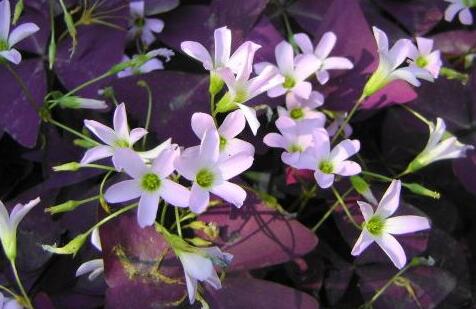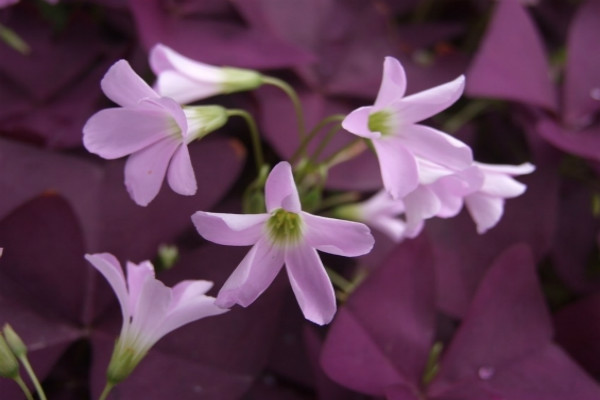Symptoms and treatment of tobacco thrips disease in Oxalis purpurea
1. Morphological characteristics
Tobacco thrips belong to Thysanoptera (Thripidea), also known as onion thrips. Tobacco thrips are minute in shape, 1.1-1.3mm in length, black, brown or yellow in color, file-sucking mouthparts, 6-9 segments of antennae, linear, long and narrow wings with long and neat marginal hairs, and degenerated claws.
two。 Occurrence regularity
Tobacco thrips occur for more than 12 generations in the greenhouse, lay eggs under the leaf epidermis and within the leaf veins, and have strong reproductive ability. Adults and nymphs lurk in soil seams, soil clods, dead branches and leaves, or in bulbs in the field and in the leaf sheaths of some plants, they can also "pupa" overwintering in the soil, but mainly adults overwinter. Activities will begin from March to April the following year. Dry and rain-free environment is beneficial to the growth, development and reproduction of tobacco thrips, while high temperature, humidity or rainstorm can inhibit its activity. Because of fear of light, tobacco thrips often climb to the leaf surface in the morning and evening and when the humidity is high in cloudy days, and feed on the back of the leaves and veins on sunny days. The adult is active, can fly and jump well, and spreads very fast.
3. Hazard characteristics
Tobacco thrips do harm to the leaves and flowers of Oxalis purpurea, but seriously to Oxalis purpurea. Tobacco thrips use file-sucking mouthparts to file the epidermis of the plant and suck its juice. Adults and nymphs are mostly harmful near petioles and veins. After the young leaves are damaged, the leaves will be distorted, deformed and grow poorly; after the leaves are damaged, there will be purple, yellow or brown markings on both the front and back, with tiny spots, and the leaf tissue will become thicker and brittle, resulting in leaf withering; flowers will appear discoloration spots after damage. In severe cases, it leads to stagnation of plant growth, decay and death.
4. Prevention and cure measures
① agricultural prevention and control:
Irrigate and spray water in time, thoroughly remove plant remains and weeds in the field and around, turn the soil deeply into the place of pupation before winter, and reduce the base of tobacco thrips.
Physical Prevention and Control of ②:
Use blue water plate or blue sticky plate to trap and kill tobacco thrips.
Chemical control of ③:
Choose 10% imidacloprid 50g and add 250g water to spray twice on the back or center of the leaf in the morning and evening. Spraying 1000 times of internal agents such as 40% omethoate and 50% fenitrothion, omethoate has an effect on flower color and should be used with caution. The control effect of thrips whitefly Jing Ec is also better.
④ biological control:
The natural enemies of tobacco thrips such as Orius minutus, Nabis sinoferus and Aeolothrips fasciatus were protected and utilized to significantly inhibit the growth and decline of the population.
How to explode the purple leaf grass, learn six skills: both beautiful and vigorous
Among the plants of the genus Oxalis, Elaeagnus angustifolia, native to South America, is famous for its colorful flowers. It is not only easy to raise but also grows very fast, but it still takes some skills to make it beautiful and grow rapidly. and how does the purple leaf grass burst the pot? Next, the editor will teach you six skills.
How to explode the purple leaf grass in the basin
1. The light should be moderate

- Prev

Symptoms and treatment of Botrytis cinerea
1. Botrytis cinerea harms leaves and bulbs of Oxalis purpurea. Yellow-brown water stains appear on the edge or corner of the damaged leaves (such as boiling water scald), and continue to expand and sink inward, making the leaves dry; after bulb damage, brown patches appear, when temperature and humidity are suitable.
- Next

Symptoms and Treatment of Myzus persicae Disease in Oxalis purpurea
1. Morphological characteristics of Myzus persicae belongs to Homoptera Aphidoidea, also known as red aphid. Myzus persicae is small, female aphid head, chest black, antenna 6, abdomen green, brown, yellow green or reddish brown, back has light black stripes
Related
- Fuxing push coffee new agricultural production and marketing class: lack of small-scale processing plants
- Jujube rice field leisure farm deep ploughing Yilan for five years to create a space for organic food and play
- Nongyu Farm-A trial of organic papaya for brave women with advanced technology
- Four points for attention in the prevention and control of diseases and insect pests of edible fungi
- How to add nutrient solution to Edible Fungi
- Is there any good way to control edible fungus mites?
- Open Inoculation Technology of Edible Fungi
- Is there any clever way to use fertilizer for edible fungus in winter?
- What agents are used to kill the pathogens of edible fungi in the mushroom shed?
- Rapid drying of Edible Fungi

